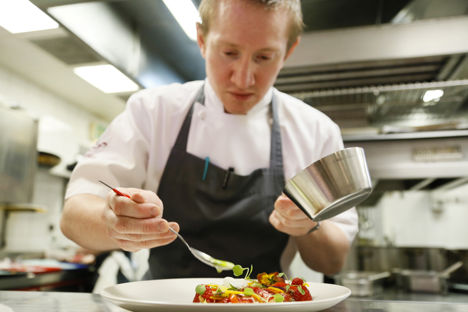
Following in big footsteps: Tom Clarke at L’Ortolan
L’Ortolan has a serious pedigree when it comes to stellar head chefs. Tom Clarke is the latest to man the pass, and over the past few years he’s taken the Berkshire restaurant to dizzying new heights.
Following in big footsteps: Tom Clarke at L’Ortolan
L’Ortolan has a serious pedigree when it comes to stellar head chefs. Tom Clarke is the latest to man the pass, and over the past few years he’s taken the Berkshire restaurant to dizzying new heights.
When we think of prestigious restaurants in the UK, we often jump to the obvious. Raymond Blanc’s Le Manoir aux Quat’Saisons, the Roux brothers at The Waterside Inn and London institutions like The Dorchester, Le Gavroche and Claridge’s. But just outside Reading in a small village called Shinfield, there’s L’Ortolan – a Michelin-starred restaurant with it’s own prestigious lineage of chefs. Nico Ladenis, John Burton Race and Alan Murchison have all graced the kitchen at L’Ortolan, which leaves three sets of big shoes to fill for Tom. But does he feel the pressure of the restaurant’s history?
‘Yes, definitely!’ he says. ‘There’s so much history here, with John Burton Race, Nico and then Alan, and what they accomplished here. There’s a lot to live up to.’
As self-effacing as Tom seems in person, he certainly has the pedigree to take the reigns at L’Ortolan. His career as a chef started young – Tom’s grandparents owned a bakery in his hometown of Chelmsford, Essex, so he was very much surrounded by bread and food. ‘They worked closely with the community, so lots of shot game, rabbits and that sort of thing would come through,’ he explains. ‘They used to hang and skin them, so I saw all that quite early on.’
It wasn’t long before Tom was working at nearby Northfield Brasserie, where his education continued thick and fast. ‘They used to get whole animals in,’ he says, ‘so before I even finished school, I knew how to break down a whole lamb or a whole deer. I was very lucky in that sense to get such an early grounding. Northfield Brasserie doesn't exist anymore sadly, but it was a great start for me.’
Tom’s journey continued through some very demanding kitchens. At just twenty-two years old, he was working at Raymond Blanc’s aforementioned Le Manoir. He stayed there for two years before heading to Shinfield for his first stint at L’Ortolan, and then spent time at legendary French two Michelin-starred restaurants Le Strato and L’Oustau de Baumanière.
‘Having worked at Le Manoir and L’Ortolan, I’d learnt a lot about French food, but I was really keen to experience it in the country itself,’ Tom says about his time in France. ‘The main thing I struggled with was the language – I went there knowing no French at all! I started as a demi-chef, but I was promoted to a senior chef de partie within two months, so suddenly I was doing orders. I had to pick up the language pretty quickly.
‘Working in France was definitely different,’ he adds. ‘It was demanding but it was nothing like working at Le Manoir. That’s a seriously tough kitchen, but it prepared me really well for L’Ortolan – Alan (Murchison) worked at Le Manoir, so there are lots of similarities there.’
After a year in France, Tom received a call from Alan at L’Ortolan, asking if he’d like to return to the fold. At the time, Tom was planning on leaving France, but a return to England was not immediately in his plans. ‘I was thinking about going to Germany, or possibly New York,’ he admits. ‘When Alan asked me to come back to L’Ortolan, I thought I was just going to help him out for a bit. After a month he offered me the head chef job!
‘Alan has been a huge role model for me,’ Tom continues. ‘He's spent so much time with me, not only teaching me how to cook, but all the other stuff outside of the kitchen. Are the glasses polished properly? Is the restaurant set up nicely? He taught me how to step back and view everything from an outside perspective.’
Tom and Alan worked together until the end of 2014, when Alan left the restaurant, and Tom took over as head chef in his own right. It’s no accident that L’Ortolan has been a huge success story since Tom’s stewardship began – gorgeous, French-influenced plates like confit salmon, elderflower and horseradish; goose liver parfait, pain d'épices and fig and peanut parfait with chocolate and cherry have drawn praise from far and wide, and retained L’Ortolan’s Michelin star and three AA Rosettes. The beauty of Tom’s cooking is in its simplicity. ‘The focus is on the flavour, instead of the number of elements on the plate,’ he explains. ‘I used to have a tendency to try to do lots of different things,’ he admits, ‘but now I’m doing more with less.’
L’Ortolan had two Michelin stars once upon a time, but when it comes to the restaurant’s future, Tom isn’t worried about awards. Instead, he’s focused on everyday changes, like having his chefs bring dishes out to guests. ‘If someone is going to explain a dish, there’s no one better to do that than the chef who prepared it,’ he says. He’s clearly committed to supporting and educating his young chefs, constantly teaching them how to prep new ingredients, giving them the same attention he appreciated at the beginning of his career.
Beyond happy staff and happy customers, awards are just a bonus. ‘I think you can get too fixated on awards,’ he says. ‘We want to keep serving good food and having happy customers. Anything we get in between that is fantastic, but our job is to feed people and give them a good experience – that is always going to be the priority.’

